Raffaele Sinibaldi (Raffaello da Montelupo) was born in Montelupo Fiorentino, near Florence. Just before his death, he wrote an account of his early life. He initially trained as a sculptor under his father Baccio, before moving to Rome in 1523 to study under Lorenzo Lotti, called Lorenzetto. The surviving fragment ends abruptly during an account of his experience of the sack of Rome in 1527, when he was about 23 years old: during this violent episode, he took refuge in the Castel Sant’ Angelo, where he served as a bombardier.
In 1530-3, when Antonio da Sangallo il Giovane took charge of the restoration of Santa Maria di Loreto, he summoned a number of other (mostly Tuscan) sculptors as assistants. This group, which included Raffaello da Montelupo and Simone Mosca, subsequently retained its coherence. For example, when Bartolommeo Bandinelli abandoned the execution of the tombs of the Medici popes Leo X and Clement VII in Santa Maria sopra Minerva, Rome in 1541, which Antonio da Sangallo il Giovane had designed, Raffaello da Montelupo was retained to complete the work.
Raffaello da Montelupo subsequently worked under Michelangelo on the Sagrestia Nuova of San Lorenzo, Florence: his statue (1533-4) of St Damian there is perhaps his masterpiece. He then stayed with Simone Mosca in Orvieto in 1536-41, working on the relief in the Cappella dei Magi of the Duomo (see below). In 1541, Raffaello da Montelupo returned to Rome, where he worked again under Michelangelo, this time on the tomb of Pope Julius II in San Pietro in Vincoli and on the tomb of Pope Leo X in Santa Maria sopra Minerva.
Tiberio Crispo, who was appointed as the castellan of Castel Sant’ Angelo in 1542, appointed Raffaello da Montelupo to oversee the restoration of the fortress and its adaptation as a papal palace. The statue (1544) of St Michael that he carved for the pinnacle is still preserved inside the castle. In the same period, Raffaello da Montelupo and Simone Mosca worked on the palace that Tiberio Crispo was building in Bolsena.
In 1550, Pope Julius III commissioned the Del Monte Chapel in San Pietro in Montorio, Rome for the monuments of his uncle, Cardinal Antonio del Monte and his great-uncle, Fabiano del Monte. Giorgio Vasari, who me appointed to design and supervise the project, under the guidance of Michelangelo, wanted to appoint Raffaello da Montelupo to sculpt the figures in the monuments, but he was over-ruled on the advice of Michelangelo, and the commission went to the young Bartolomeo Ammananati. It seems likely that Raffaello designed the very similar Cappella Farrattini (ca. 1560) in the Duomo of Amelia for Baldo Farrattini, and that he recommended two of his young associates to work on the toms there:
-
✴Giovanni Antonio Dosio, who had trained in the workshop of Raffaello da Montelupo in Rome in 1548-51; and
-
✴Ippolito Scalza, who had begun work at the Duomo of his native Orvieto under Raffaello da Montelupo 1554.
When Simone Mosca died in 1553, Raffaello da Montelupo succeeded him as capomastro of the Opera del Duomo at Orvieto. Giorgio Vasari records that, “having given himself up to the sort of life fit rather for a philosopher than for a sculptor, and wishing to live in peace, [Raffaello] retired to Orvieto, where he undertook the charge of the building of Santa Maria, in which he made many improvements; and with this he occupied himself for many years, growing old before his time”. Raffaello da Montelupo held this post until his death in 1566.
Orvieto
Duomo
Rafaello da Montelupo was heavily involved in the 16th century remodelling of the Duomo even before he became capomaestro in 1553.
Relief of the Cappella dei Magi (1536-41)
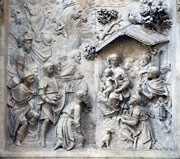
Michele Sanmicheli demolished an earlier version of this chapel on the left wall of the right transept of the Duomo, and began a new one in 1514. Only the pediment had been built by the time that he left Orvieto in 1526. The Opera del Duomo commissioned a new design from Antonio da Sangallo il Giovane. Pope Clement VII, who took refuge in Orvieto in December 1527 after the sack of Rome, was asked to decide between the two designs and chose the former, although the side pilaster shown in Antonio da Sangallo’s design was used in the structure that was actually built.
Antonio da Sangallo arranged for Simone Mosca to take over the project in 1535. According the Giorgio Vasari, “there was summoned, at the suggestion of Simone, his very dear friend Raffaello da Montelupo” to work on the central relief under the arch. A document records that Simone Mosca acted as host to Antonio da Sangallo when he made a short visit in 1536 to introduce Raffaello da Montelupo to the authorities.
The lower part of the relief was presumably complete by 1541, when Raffaello da Montelupo was back in Rome. It depicts the Magi adoring the Madonna and Child in a stable. The main figures are in deep relief: a number of camels, including one ridden by a monkey, are drawn in shallow relief in the background. According to Giorgio Vasari, the young Francesco Mosca, il Moschino subsequently executed the group of angels in the upper part of the central relief, the relief of God the Father in the pediment, the angels in the lunette and the Victories to the sides of it. The chapel itself was finally completed in 1546.
Cappella della Visitazione (1547-54)
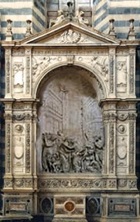
Vasari added that the relief of the Visitation at its centre was commissioned from Simone’s son, Francesco Mosca, il Moschino. The young Ippolito Scalza seems to have worked as an assistant on the project.
Risen Christ (1544)
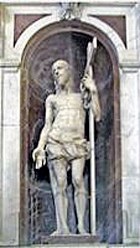
Payment for the figure by Raffaello da Montelupo is documented in 1544. It was probably inspired by the Risen Christ (1518-20) by Michelangelo in Santa Maria sopra Minerva, Rome. It was subsequently moved to the niche (1555) that Simone Mosca built to the right of the entrance to the Cappella del Corporale. It is now in a pendant niche (1565-6) to the left of the entrance to the Cappella del Corporale, in the left transept of the Duomo. (Its original niche is now occupied by a figure (1579-82) of the Virgin by Fabiano Toti).
Chapels in the Nave (1555-66)
Raffaello da Montelupo was first consulted about a plan to replace the chapels in the five niches in each of the walls of the nave in 1555, when he recommended the young Girolamo Muziano as a suitable artist for the work of decorating the new ones. A plan to demolish the niches and to build new side chapels aligned with the pillars was discussed in 1556. However, this plan was rejected in favour of a cheaper alternative that involved building new chapels in the existing niches. Each new chapel was to conform to a design by Raffaello da Montelupo and to be decorated in stucco and fresco.
Work on the five new chapels in the left aisle began in ca. 1556 and was probably complete by 1570. In that year, Ippolito Scalza (who had been commissioned to decorate on of the altars in the left aisle in 1564 and who been elected capomaestro in 1567) wrote to the Opera del Duomo to urge that marble should be used for the altars in the right aisle, pointing out that the earlier stucco work was already deteriorating. However, the decision ultimately went against him. The programme was completed in stucco by ca. 1575.
These chapels were destroyed in ca. 1890.
Sacramental Tabernacle (1554-64)
In 1554, the Opera del Duomo and Compagnia del Corpus Christi commissioned a new tabernacle for the consecrated host. The initial plan was for a marble tabernacle, but this was changed to gilded wood, probably so that the structure could be executed on a more monumental scale. This was one of the earliest sacramental altars of its type in Italy and was designed to be placed on the high altar, where it would provide the devotional focus of the church.
Raffaello da Montelupo completed the design of the tabernacle in 1558 and Ippolito Scalza executed it in 1558-60. It was installed in ca. 1560 and gilded in 1563. Cesare Nebbia painted eleven panels for it soon after. The tabernacle, which was moved from the high altar to the back of the tribune in 1629, was destroyed in the late 18th century. The panels by Cesare Nebbia were re-discovered recently and are now exhibited in the Museo del Opera del Duomo.
St Peter (1560)
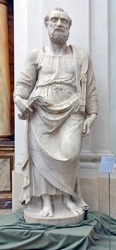
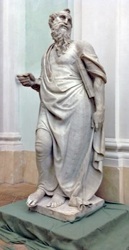
St Peter (1560) by St Paul (1556) by
Raffaello da Montelupo Francesco Mosca, il Moschino
Giorgio Vasari recorded that: “Work being then continued on the execution of the Apostles for the church, [Francesco Mosca, il Moschino] made a St Peter and a St Paul of the same size, which were held to be creditable statues”. Documents relating to this commission began in 1554, when the Opera del Duomo sent Francesco Mosca to Carrara to obtain marble for four planned sculptures:
-
✴these over life-sized statues of SS Peter and Paul;
-
✴a figure of St Sebastian (see below);
-
✴and a group of the Pietà.
The choice of the three saints was probably intended to underline the strong links between Orvieto and papal Rome.
In fact, the marble did not reach Orvieto until 1556, and Francesco Mosca had completed only the figure of St Paul before he left Orvieto later that year. The figure was subsequently placed by the first column on the right. Raffaello da Montelupo executed the figure of St Peter in 1560, and this was placed as a pendant to St Paul (i.e. by the first column on the left). These did indeed become the first of a series of figures of the Apostles in the nave. All of these figures are now exhibited in the ex-church of Sant’ Agostino.
Eve (1560s ?)

Apostles (1560-6)

A team under Raffaello da Montelupo began work on the figures of Apostles for the niches above the rose window in the facade of the Duomo in 1560. The middle four figure (two of which are illustrated here) are attributed to him. Work continued until 1570, by which time Raffaello da Montelupo was dead. The four to the right, which presumably belong to the later phase of the project, are attributed to Fabiano Toti.
St Michael (ca. 1561)
This marble figure was commissioned from Raffaello da Montelupo to stand above the right entrance in the facade of the Duomo, “facing to the church of San Giacomo". It must have been completed by 1561, when copper for its wings and gold leaf were purchased. It was restored in 1816. It was moved to the Museo dell’ Opera del Duomo in 1964 and replaced by a copy.
The figure depicts St Michael standing in front of a chained kneeling figure of a bearded man [the Devil ?]. Its iconography was obviously based on the figure (1544) of St Michael that Raffaello da Montelupo executed for the top of the Castel Sant' Angelo, Rome.
Palazzo Crispo Marsciano (ca. 1536-80)
Tiberio Crispo was the son of Giovanni Battista Crispo and his wife (and then widow) Silvia. His mother was the mistress of Cardinal Alessandro Farnese (later Pope Paul III) and the mother of three boys, (Pier Luigi, Paolo and Ranuccio), whom he recognised and legitimised. The fact that Tiberio Crispo was not recognised and legitimised suggests that he had been conceived before Silvia’s relationship with Cardinal Farnese began. He certainly prospered once Cardinal Farnese was elected to the papacy: as Paul III, he appointed him as governor of Perugia in 1540 and as castellan of the Castel Sant’ Angelo in Rome in 1542 (as noted above), and made him a cardinal in 1544. He returned to Perugia as papal legate in 1545.
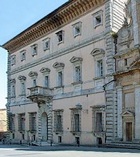
It seems likely that Raffaello da Montelupo, with whom both Tiberio Crispo and Antonio da Sangallo had close links, took over the project. There seems to have been a spurt in activity on it in 1551. However, the work subsequently proceeded intermittently, and the palace was still incomplete when both Tiberio Crispo and Raffaelo da Montelupo died in 1566.
Ludovico Marsciano bought the incomplete palace in 1582. The work he commissioned, which included the windows in the upper storeys, is attributed to Ippolito Scalza.
Restoration of Public Palaces (1553-64)
Raffaello da Montelupo is documented in relation to two public palaces in 1564:
-
✴Palazzo del Governatore (previously Palazzo dei Sette); and
-
✴Palazzo del Podestà (previously Palazzo del Popolo).
It seems likely that he had directed the entire phase of the respective restoration, which seem to have begun in 1553 and 1557 respectively .
San Lorenzo delle Vigne (1557-61)
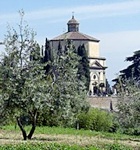
St Antony of Padua (16th century)
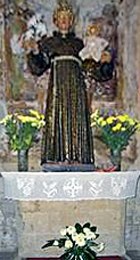
Amelia
Cappella Farrattini (ca. 1560)
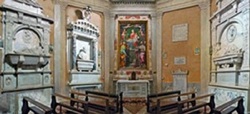
It is possible that Raffaello da Montelupo designed the Cappella Farrattini, which Baldo Farrattini commissioned for the Duomo, Amelia. He also probably recommended two of his young associates, Giovanni Antonio Dosio and Ippolito Scalza, for commissions in relation to the funerary monuments there.
Read more:
F. Piagnani and L. Principi, “La Scultura del Cinquecento in Orvieto”, in
C. Benocci et al. (Eds), “Storia di Orvieto: Quattrocento e Cinquecento” (2010) Pisa, Volume II, pp 585-636
R. Gatteschi, “Vita da Raffaello da Montelupo”, (1998) Florence
T. Verellen, “Patterns of Patronage: Antonio da Sangallo the Younger and the Setta of Sculptors”,
in F. Kent et al. (Eds), “Patronage, Art and Society in Renaissance Italy”, (1987) Oxford
Return to Art in: Amelia Orvieto.
Return to “Foreign” Sculptors in Umbria.



